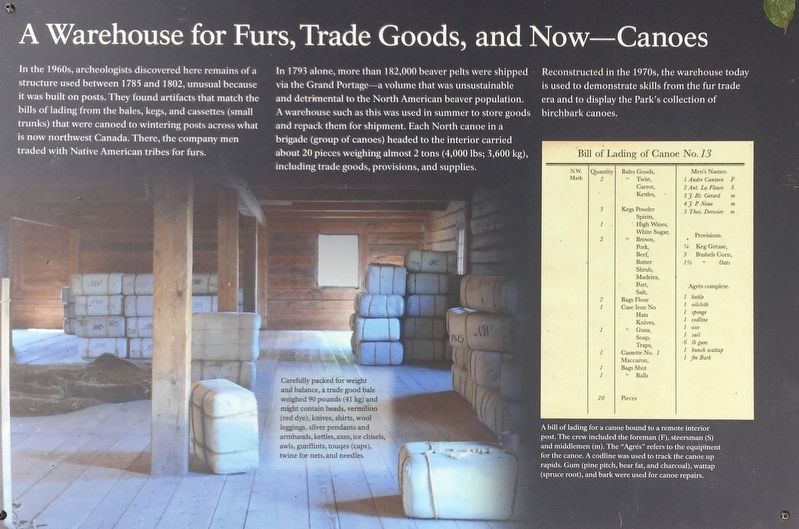A Warehouse for Furs, Trade Goods, and Now—Canoes
In 1793 alone, more than 182,000 beaver pelts were shipped via the Grand Portage—a volume that was unsustainable and detrimental to the North American beaver population. A warehouse such as this was used in summer to store goods and repack them for shipment. Each North canoe in a brigade (group of canoes) headed to the interior carried about 20 pieces weighing almost 2 tons (4,000 lbs; 3,600 kg) including trade goods, provisions, and supplies. Reconstructed in the 1970s, the warehouse today is used to demonstrate skills from the fur trade era and to display the Parks collection of birchbark canoes.
Photo captions:
Middle: Carefully packed for weight
and balance, a trade good bale
weighed 90 pounds (41 kg) and
might contain beads, vermilion
(red dye), knives, shirts, wool
leggings, silver pendants and
armbands, kettles, axes, ice chisels,
awls, gunflints, touqes (caps),
twine for nets, and needles.
Right:A bill of lading for
a canoe bound to a remote interior
post. The crew included the foreman (F), steersman (S)
and middlemen (m). The “Agrés” refers to the equipment
for the canoe. A codline was used to track the canoe up
rapids. Gum (pine pitch, bear fat, and charcoal), wattap
(spruce root), and bark were used for canoe repairs.
Erected by National Park Service.
Topics. This historical marker is listed in these topic lists: Industry & Commerce • Native Americans • Parks & Recreational Areas.
Location. 47° 57.712′ N, 89° 41.132′ W. Marker is in Grand Portage, Minnesota, in Cook County. Marker can be reached from Mill Creek Road, 0.2 miles south of Store Road. Located at the Grand Portage National Monument. Touch for map. Marker is at or near this postal address: 112 Mill Creek Rd, Grand Portage MN 55605, United States of America. Touch for directions.
Other nearby markers. At least 8 other markers are within walking distance of this marker. The North West Company (within shouting distance of this marker); Voyageurs at Grand Portage (within shouting distance of this marker); North West Company Depot (within shouting distance of this marker); The Birchbark Canoe (within shouting distance of this marker); North West Company Fur Press (about 300 feet away, measured in a direct line);
Credits. This page was last revised on July 20, 2020. It was originally submitted on July 17, 2020, by Connor Olson of Kewaskum, Wisconsin. This page has been viewed 205 times since then and 40 times this year. Photos: 1. submitted on July 17, 2020, by Connor Olson of Kewaskum, Wisconsin. 2, 3. submitted on July 19, 2020, by Connor Olson of Kewaskum, Wisconsin. • Mark Hilton was the editor who published this page.
Editor’s want-list for this marker. A wide shot of the marker and its surroundings • Can you help?


